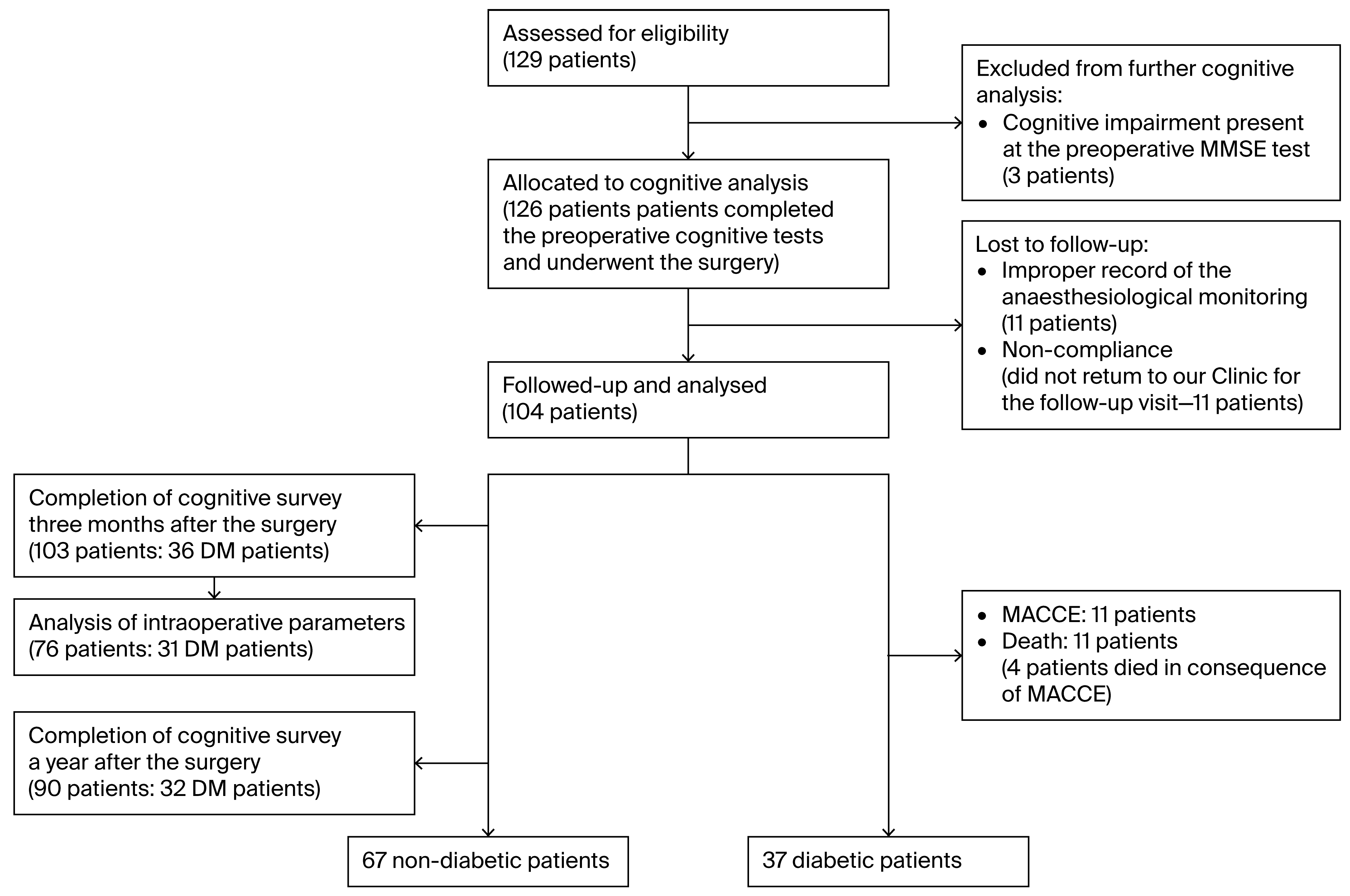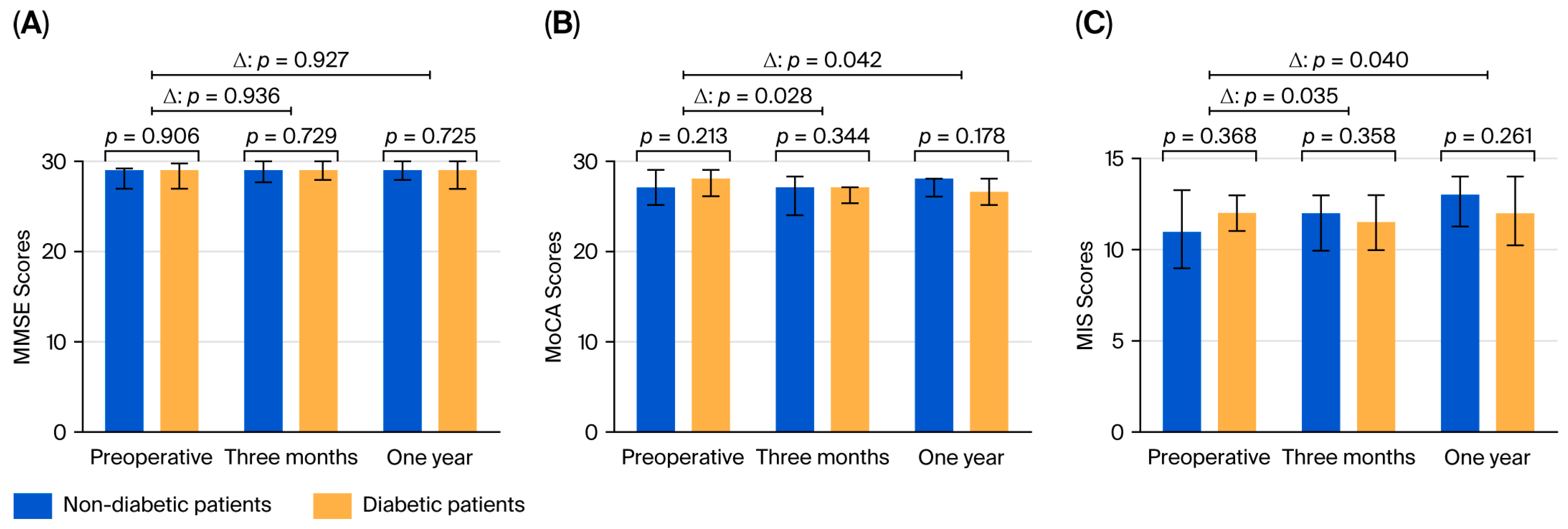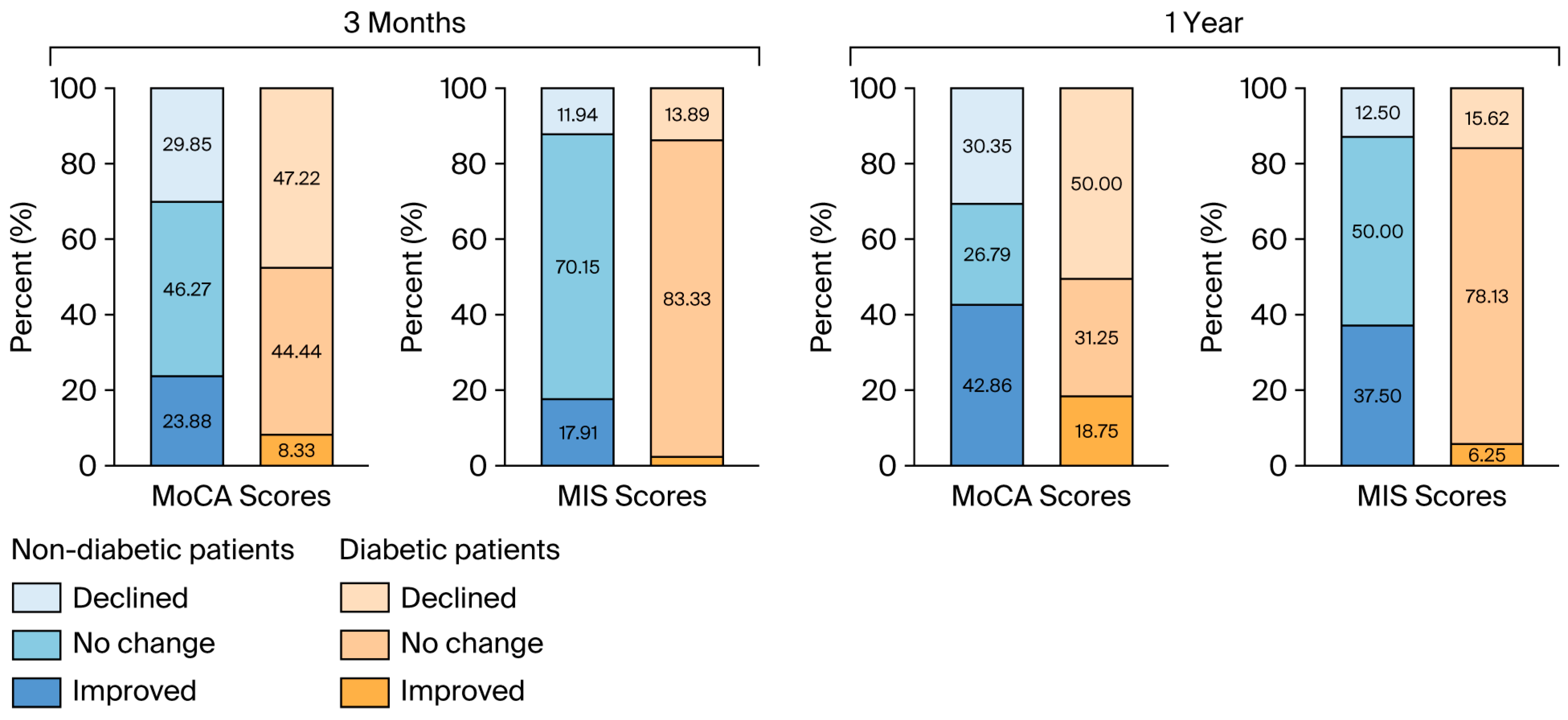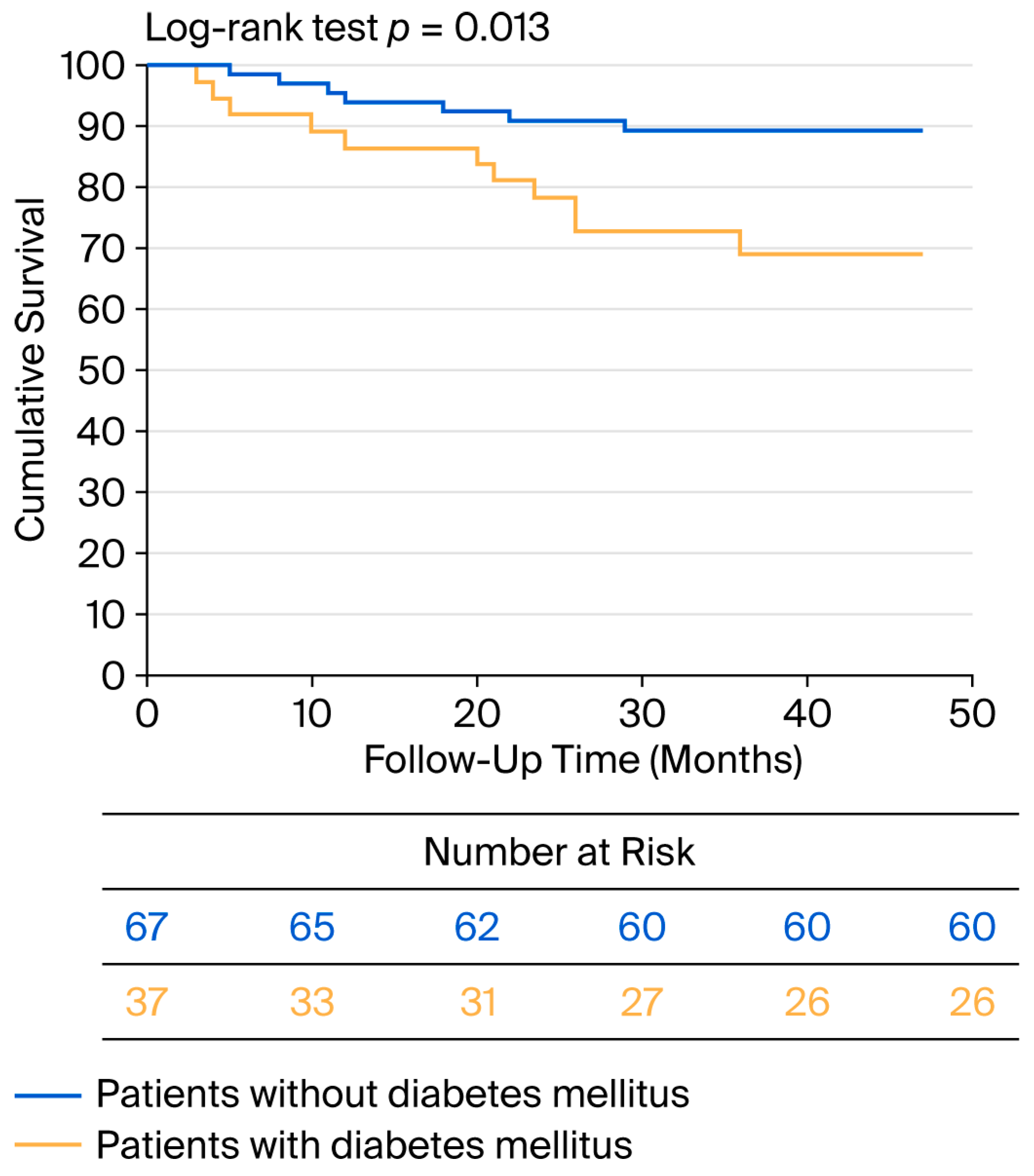Association of Diabetes with Greater Mid-Term Cognitive Decline After Carotid Surgery
Abstract
1. Introduction
2. Materials and Methods
3. Results
3.1. Baseline Characteristics
3.2. Cognitive Evaluation
3.3. Major Adverse Cerebral and Cardiovascular Events
3.4. Intraoperative Parameters
4. Discussion
5. Conclusions
Supplementary Materials
Author Contributions
Funding
Institutional Review Board Statement
Informed Consent Statement
Data Availability Statement
Conflicts of Interest
Abbreviations
| ASA score | American Society of Anesthesiologists physical status classification |
| BMI | body mass index |
| CCA | common carotid artery |
| CEA | carotid endarterectomy |
| C.I. | confidence interval |
| COPD | chronic obstructive pulmonary disease |
| CoW | Circle of Willis |
| DAP | diastolic arterial blood pressure |
| EEA | eversion endarterectomy |
| EtCO2 | end-tidal carbon dioxide |
| HR | heart rate |
| ICA | internal carotid artery |
| IQR | interquartile range |
| MAP | mean arterial pressure |
| MIS | Memory Index Score |
| MMSE | Mini-Mental State Examination |
| MoCA | Montreal Cognitive Assessment |
| NASCET | North American Symptomatic Carotid Endarterectomy Trial |
| NIRS | near-infrared spectroscopy |
| OR | odds ratio |
| PAD | peripheral arterial disease |
| PNCD | perioperative neurocognitive disorder |
| rSO2 | regional cerebral oxygen saturation |
| rSO2preclamp | median of regional cerebral oxygen saturation during the preclamping period |
| rSO2lowestclamp | lowest rSO2 values during the clamping period |
| SAP | systolic arterial blood pressure |
| SD | standard deviation |
| TEA | thromboendarterectomy |
| Vascular-POSSUM | Vascular-Physiological and Operative Severity Score for the enUmeration of Mortality and Morbidity |
Appendix A
| Characteristics | Pre-Clamp | Cross-Clamp | Post-Clamp | ||||||
|---|---|---|---|---|---|---|---|---|---|
| HR | 67.6 (7.8) | 64.6 (9.9) | 0.118 | 70.4 (18.2) | 62.4 (17.6) | 0.125 | 71.8 (14.2) | 64.6 (12.5) | 0.035 |
| ETCO2 difference | 2.4 (1.7) | 2.9 (2.1) | 0.425 | 1.7 (0.7) | 1.3 (0.7) | 0.018 | 4.5 (3.9) | 4.1 (2.4) | 0.315 |
| DAP mean | 59.7 (12.6) | 58.1 (10.7) | 0.173 | 69.7 (11.9) | 62.2 (10.6) | 0.021 | 60.5 (15.6) | 60.1 (10.4) | 0.258 |
| DAP minimum | 43.5 (10.1) | 41.4 (11.0) | 0.104 | 59.8 (12.7) | 53.2 (12.4) | 0.037 | 46.7 (11.1) | 45.9 (11.0) | 0.208 |
| SAP mean | 128.7 (19.2) | 119.5 (17.0) | 0.036 | 145.8 (20.8) | 131.3 (22.8) | 0.000 | 134.8 (28.5) | 125.6 (19.4) | 0.034 |
| SAP minimum | 91.8 (20.6) | 86.2 (16.9) | 0.123 | 120.0 (22.1) | 107.6 (28.5) | 0.002 | 93.8 (18.4) | 92.0 (17.2) | 0.272 |
| MAP mean | 85.9 (16.7) | 80.5 (10.4) | 0.099 | 97.9 (12.5) | 86.7 (15.4) | 0.001 | 85.9 (15.9) | 82.5 (11.7) | 0.089 |
| MAP minimum | 61.4 (11.9) | 56.0 (11.9) | 0.125 | 84.0 (13.5) | 72.4 (15.6) | 0.013 | 61.1 (13.8) | 61.7 (13.2) | 0.286 |
| vasopressor use (%) | 29 (78.37) | 26 (38.80) | 0.001 | 29 (78.37) | 36 (53.73) | 0.099 | 25 (67.56) | 25 (37.31) | 0.023 |
| vasopressor (ug) | 13.32 (5.24–25.45) | 5 (0–14.16) | 0.005 | 141.56 (42.44–222.93) | 38.08 (5–89.37) | 0.003 | 14.16 (2.18–29.16) | 8.33 (0–15.83) | 0.033 |
| Characteristics | Pre-Clamp | Cross-Clamp | Post-Clamp | ||||||
|---|---|---|---|---|---|---|---|---|---|
| Diabetic Group | Nondiabetic Group | p Value | Diabetic Group | Nondiabetic Group | p Value | Diabetic Group | Nondiabetic Group | p Value | |
| rSO2 ipsilateral mean | 67.4 (10.4) | 74.6 (7.9) | 0.011 | 59.6 (11.9) | 64.4 (12.8) | 0.133 | 67.4 (10.8) | 72.4 (14.9) | 0.169 |
| rSO2 contralateral mean | 71.1 (8.3) | 76.3 (13.8) | 0.076 | 70.1 (6.9) | 75.0 (14.9) | 0.186 | 70.2 (8.1) | 74.6 (12.5) | 0.205 |
| rSO2 ipsilateral minimum | 61.1 (9.9) | 68.3 (13.1) | 0.033 | 54.4 (14.5) | 60.0 (15.7) | 0.052 | 60.0 (10.1) | 64.5 (15.3) | 0.241 |
| SE difference | 10.4 (8.7) | 12.4 (7.3) | 0.648 | 6.0 (7.4) | 5.5 (5.1) | 0.442 | 16.7 (13.6) | 11.4 (8.3) | 0.009 |
| SE minimum | 37.5 (9.1) | 34.9 (12.8) | 0.901 | 31.8 (18.4) | 40.9 (20.1) | 0.292 | 29.1 (17.5) | 37.6 (17.9) | 0.003 |
References
- International Diabetes Federation. IDF Diabetes Atlas, 10th Edition. 2021. Available online: https://diabetesatlas.org/atlas/tenth-edition/ (accessed on 6 December 2021).
- Naylor, R.; Rantner, B.; Ancetti, S.; De Borst, G.J.; De Carlo, M.; Halliday, A.; Kakkos, S.K.; Markus, H.S.; McCabe, D.J.H.; Sillesen, H.; et al. European Society for Vascular Surgery (ESVS) 2023 Clinical Practice Guidelines on the Management of Atherosclerotic Carotid and Vertebral Artery Disease. Eur. J. Vasc. Endovasc. Surg. 2023, 65, 7–111. [Google Scholar] [CrossRef]
- Krawisz, A.K.; Carroll, B.J.; Secemsky, E.A. Risk Stratification and Management of Extracranial Carotid Artery Disease. Cardiol. Clin. 2021, 39, 539–549. [Google Scholar] [CrossRef]
- Tuomilehto, J.; Rastenyte, D.; Jousilahti, P.; Sarti, C.; Vartiainen, E. Diabetes mellitus as a risk factor for death from stroke Prospective study of the middle-aged Finnish population. Stroke 1996, 27, 210–215. [Google Scholar] [CrossRef]
- Kurukulasuriya, L.R.; Govindarajan, G.; Sowers, J. Stroke prevention in diabetes and obesity. Expert Rev. Cardiovasc. Ther. 2006, 4, 487–502. [Google Scholar] [CrossRef] [PubMed]
- Mizuhashi, S.; Kataoka, H.; Sano, N.; Ideguchi, M.; Higashi, M.; Miyamoto, Y.; Iihara, K. Impact of diabetes mellitus on characteristics of carotid plaques and outcomes after carotid endarterectomy. Acta Neurochir. 2014, 156, 927–933. [Google Scholar] [CrossRef]
- Dimic, A.; Markovic, M.; Vasic, D.; Dragas, M.; Zlatanovic, P.; Mitrovic, A.; Davidovic, L. Impact of diabetes mellitus on early outcome of carotid endarterectomy. Vasa 2019, 48, 148–156. [Google Scholar] [CrossRef]
- Parlani, G.; De Rango, P.; Cieri, E.; Verzini, F.; Giordano, G.; Simonte, G.; Isernia, G.; Cao, P. Diabetes is not a predictor of outcome for carotid revascularization with stenting as it may be for carotid endarterectomy. J. Vasc. Surg. 2012, 55, 79–89. [Google Scholar] [CrossRef] [PubMed]
- Relander, K.; Hietanen, M.; Nuotio, K.; Ijäs, P.; Tikkala, I.; Saimanen, E.; Lindsberg, P.J.; Soinne, L. Cognitive Dysfunction and Mortality After Carotid Endarterectomy. Front. Neurol. 2021, 11, 593719. [Google Scholar] [CrossRef]
- Suraarunsumrit, P.; Pathonsmith, C.; Srinonprasert, V.; Sangarunakul, N.; Jiraphorncharas, C.; Siriussawakul, A. Postoperative cognitive dysfunction in older surgical patients associated with increased healthcare utilization: A prospective study from an upper-middle-income country. BMC Geriatr. 2022, 22, 213. [Google Scholar] [CrossRef] [PubMed]
- Ton, T.G.N.; DeLeire, T.; May, S.G.; Hou, N.; Tebeka, M.G.; Chen, E.; Chodosh, J. The financial burden and health care utilization patterns associated with amnestic mild cognitive impairment. Alzheimers Demen. 2017, 13, 217–224. [Google Scholar] [CrossRef]
- Piegza, M.; Wieckiewicz, G.; Wierzba, D.; Piegza, J. Cognitive Functions in Patients after Carotid Artery Revascularization—A Narrative Review. Brain Sci. 2021, 11, 1307. [Google Scholar] [CrossRef]
- Aceto, P.; Lai, C.; De Crescenzo, F.; Crea, M.A.; Di Franco, V.; Pellicano, G.R.; Perilli, V.; Lai, S.; Papanice, D.; Sollazzi, L. Cognitive decline after carotid endarterectomy: Systematic review and meta-analysis. Eur. J. Anaesthesiol. 2019, 37, 1066–1074. [Google Scholar] [CrossRef]
- Liu, H.; Chen, J.; Ling, J.; Wu, Y.; Yang, P.; Liu, X.; Liu, J.; Zhang, D.; Yin, X.; Yu, P.; et al. The association between diabetes mellitus and postoperative cognitive dysfunction: A systematic review and meta-analysis. Int. J. Surg. 2025, 111, 633–2650. [Google Scholar] [CrossRef]
- Long, C.A.; Fang, Z.B.; Hu, F.Y.; Arya, S.; Brewster, L.P.; Duggan, E.; Duwayri, Y. Poor glycemic control is a strong predictor of postoperative morbidity and mortality in patients undergoing vascular surgery. J. Vasc. Surg. 2019, 69, 1219–1226. [Google Scholar] [CrossRef] [PubMed]
- Yamashita, T.; Ogasawara, K.; Kuroda, H.; Suzuki, T.; Chida, K.; Kobayashi, M.; Yoshida, K.; Kubo, Y.; Ogawa, A. Combination of preoperative cerebral blood flow and 123I-iomazenil SPECT imaging predicts postoperative cognitive improvement in patients undergoing uncomplicated endarterectomy for unilateral carotid stenosis. Clin. Nucl. Med. 2012, 37, 128–133. [Google Scholar] [CrossRef] [PubMed]
- Lazkani, A.; Lebuffe, G. Post-operative consequences of hemodynamic optimization. J. Visc. Surg. 2016, 153, S5–S9. [Google Scholar] [CrossRef] [PubMed]
- Vuurberg, N.E.; Post, I.C.J.H.; Keller, B.P.J.A.; Schaafsma, A.; Vos, C.G. A Systematic Review and Meta-Analysis on Perioperative Cerebral and Hemodynamic Monitoring Methods during Carotid Endarterectomy. Ann. Vasc. Surg. 2023, 88, 384–409. [Google Scholar] [CrossRef]
- Wang, Y.; Li, L.; Wang, T.; Zhao, L.; Feng, H.; Wang, Q.; Fan, L.; Feng, X.; Xiao, W.; Feng, K. The Efficacy of Near-Infrared Spectroscopy Monitoring in Carotid Endarterectomy: A Prospective, Single-Center, Observational Study. Cell Transpl. 2019, 28, 170–175. [Google Scholar] [CrossRef]
- Ding, X.; Zha, T.; Abudurousuli, G.; Zhao, C.; Chen, Z.; Zhang, Y.; Gui, B. Effects of regional cerebral oxygen saturation monitoring on postoperative cognitive dysfunction in older patients: A systematic review and meta-analysis. BMC Geriatr. 2023, 23, 123. [Google Scholar] [CrossRef]
- Cotae, A.-M.; Ţigliş, M.; Cobilinschi, C.; Băetu, A.E.; Iacob, D.M.; Grinţescu, I.M. The Impact of Monitoring Depth of Anesthesia and Nociception on Postoperative Cognitive Function in Adult Multiple Trauma Patients. Medicina 2021, 57, 408. [Google Scholar] [CrossRef]
- Pinto, T.C.C.; Machado, L.; Bulgacov, T.M.; Rodrigues-Júnior, A.L.; Costa, M.L.G.; Ximenes, R.C.C.; Sougey, E.B. Is the Montreal Cognitive Assessment (MoCA) screening superior to the Mini-Mental State Examination (MMSE) in the detection of mild cognitive impairment (MCI) and Alzheimer’s Disease (AD) in the elderly? Int. Psychogeriatr. 2019, 31, 491–504. [Google Scholar] [CrossRef] [PubMed]
- Fasnacht, J.S.; Wueest, A.S.; Berres, M.; Thomann, A.E.; Krumm, S.; Gutbrod, K.; Steiner, L.A.; Goettel, N.; Monsch, A.U. Conversion between the Montreal Cognitive Assessment and the Mini-Mental Status Examination. J. Am. Geriatr. Soc. 2023, 71, 869–879. [Google Scholar] [CrossRef] [PubMed]
- Kaur, A.S.; Edland, D.; Peavy, G.M. The MoCA Memory Index Score: An Efficient Alternative to Paragraph Recall for the Detection of Amnestic Mild Cognitive Impairment. Alzheimer Dis. Assoc. Disord. 2018, 32, 120–124. [Google Scholar] [CrossRef]
- World Health Organization. Classification of Diabetes Mellitus. 2019. Available online: https://www.who.int/publications/i/item/classification-of-diabetes-mellitus (accessed on 21 April 2019).
- Centre for Perioperative Care; Academy of Medical Royal Colleges. Guideline for Perioperative Care for People with Diabetes Mellitus Undergoing Elective and Emergency Surgery. 2021. Available online: https://cpoc.org.uk/sites/cpoc/files/documents/2024-03/CPOC-DiabetesGuideline2023.pdf (accessed on 8 March 2021).
- Blecha, M.; Weise, L.; Liu, A.; Yuan, K.; Terry, T.; Paraskevas, K.I. Risk score for two-year mortality following carotid endarterectomy performed for symptomatic stenosis. J. Vasc. Surg. 2025, 81, 905–918. [Google Scholar] [CrossRef]
- Singh, S.; Bansal, S.; Kumar, G.; Gupta, I.; Thakur, J.R. Entropy as an Indicator to Measure Depth of Anaesthesia for Laryngeal Mask Airway (LMA) Insertion during Sevoflurane and Propofol Anaesthesia. J. Clin. Diagn. Res. 2017, 11, UC01–UC03. [Google Scholar] [CrossRef]
- Bikbov, M.M.; Kazakbaeva, G.M.; Iakupova, E.M.; Panda-Jonas, S.; Fakhretdinova, A.A.; Tuliakova, A.M.; Rusakova, I.A.; Jonas, J.B. Cognitive impairment in the population-based ural very old study. Front. Ageing Neurosci. 2022, 14, 912755. [Google Scholar] [CrossRef]
- Kessels, R.P.C.; De Vent, N.R.; Bruijnen, C.J.W.H.; Jansen, M.G.; de Jonghe, J.F.M.; Dijkstra, B.A.G.; Oosterman, J.M. Regression-Based Normative Data for the Montreal Cognitive Assessment (MoCA) and Its Memory Index Score (MoCA-MIS) for Individuals Aged 18–91. J. Clin. Med. 2022, 11, 4059. [Google Scholar] [CrossRef]
- Mahanna, E.P.; Blumenthal, J.A.; White, W.D.; Croughwell, N.D.; Clancy, C.P.; Smith, L.R.; Newman, M.F. Defining neuropsychological dysfunction after coronary artery bypass grafting. Ann. Thorac. Surg. 1996, 61, 1342–1347. [Google Scholar] [CrossRef]
- Varpaei, H.A.; Farhadi, K.; Mohammadi, M.; Khafaee pour khamseh, A.; Mokhtari, T. Postoperative cognitive dysfunction: A concept analysis. Aging Clin. Exp. Res. 2024, 36, 133. [Google Scholar] [CrossRef] [PubMed]
- Julayanont, P.; Brousseau, M.; Chertkow, H.; Phillips, N.; Nasreddine, Z.S. Montreal Cognitive Assessment Memory Index Score (MoCA-MIS) as a predictor of conversion from mild cognitive impairment to Alzheimer’s disease. J. Am. Geriatr. Soc. 2014, 62, 679–684. [Google Scholar] [CrossRef]
- Feinkohl, I.; Winterer, G.; Pischon, T. Diabetes is associated with risk of postoperative cognitive dysfunction: A meta-analysis. Diabetes Metab. Res. Rev. 2017, 33, e2884. [Google Scholar] [CrossRef]
- Seven, S.; Ceylan, Í.; Kaymak, D.; Kara, A.G.; Erden, V. The effect of type 2 diabetes mellitus on early postoperative cognitive functions. J. Surg. Med. 2022, 6, 552–556. [Google Scholar] [CrossRef]
- Gupta, M.; Pandey, S.; Rumman, M.; Singh, B.; Mahdi, A.A. Molecular mechanisms underlying hyperglycemia associated cognitive decline. IBRO Neurosci. Rep. 2023, 14, 57–63. [Google Scholar] [CrossRef]
- Zhang, S.; Zhang, Y.; Wen, Z.; Yang, Y.; Bu, T.; Bu, X.; Ni, Q. Cognitive dysfunction in diabetes: Abnormal glucose metabolic regulation in the brain. Front. Endocrinol. 2023, 14, 1192602. [Google Scholar] [CrossRef]
- Kwon, S.; Thompson, R.; Dellinger, P.; Yanez, D.; Farrohki, E.; Flum, D. Importance of perioperative glycemic control in general surgery: A report from the Surgical Care and Outcomes Assessment Program. Ann. Surg. 2013, 257, 8–14. [Google Scholar] [CrossRef]
- Pinto, T.C.C.; Machado, L.; Costa, M.L.G.; Santos, M.S.P.; Bulgacov, T.M.; Rolim, A.P.P.; Silva, G.A.; Rodrigues-Júnior, A.L.; Sougey, E.B.; Ximenes, R.C.C. Accuracy and Psychometric Properties of the Brazilian Version of the Montreal Cognitive Assessment as a Brief Screening Tool for Mild Cognitive Impairment and Alzheimer’s Disease in the Initial Stages in the Elderly. Dement. Geriatr. Cogn. Disord. 2019, 47, 366–374. [Google Scholar] [CrossRef] [PubMed]
- Ciesielska, N.; Sokolowski, R.; Mazur, E.; Podhorecka, M.; Polak-Szabela, A.; Kędziora-Kornatowska, K. Is the Montreal Cognitive Assessment (MoCA) test better suited than the Mini-Mental State Examination (MMSE) in mild cognitive impairment (MCI) detection among people aged over 60? Meta-analysis. Psychiatr. Pol. 2016, 50, 1039–1052. [Google Scholar] [CrossRef] [PubMed]
- Qin, X.W.; Chen, X.L.; Yao, L. The value of intraoperative monitoring of cerebral oxygen saturation on postoperative cognitive function in elderly patients undergoing cardiac surgery. Zhonghua Yi Xue Za Zhi 2021, 101, 345–349. [Google Scholar] [CrossRef] [PubMed]
- Uysal, S.; Lin, H.M.; Trinh, M.; Park, C.H.; Reich, D.L. Optimizing cerebral oxygenation in cardiac surgery: A randomized controlled trial examining neurocognitive and perioperative outcomes. J. Thorac. Cardiovasc. Surg. 2020, 159, 943–953. [Google Scholar] [CrossRef]
- Soh, S.; Shim, J.K.; Song, J.W.; Choi, N.; Kwak, Y.L. Preoperative transcranial Doppler and cerebral oximetry as predictors of delirium following valvular heart surgery: A case-control study. J. Clin. Monit. Comput. 2020, 34, 715–723. [Google Scholar] [CrossRef]
- Kazan, R.; Bracco, D.; Hemmerling, T.M. Reduced cerebral oxygen saturation measured by absolute cerebral oximetry during thoracic surgery correlates with postoperative complications. Br. J. Anaesth. 2009, 103, 811–816. [Google Scholar] [CrossRef]
- Eyeington, C.T.; Ancona, P.; Osawa, E.A.; Cutuli, S.L.; Eastwood, G.M.; Bellomo, R. Modern technology–derived normative values for cerebral tissue oxygen saturation in adults. Anaesth. Intensive Care 2019, 47, 69–75. [Google Scholar] [CrossRef] [PubMed]
- Van Sloten, T.T.; Sedaghat, S.; Carnethon, M.R.; Launer, L.J.; Stehouwer, C.D. Cerebral microvascular complications of type 2 diabetes: Stroke, cognitive dysfunction, and depression. Lancet Diabetes Endocrinol. 2020, 8, 325–336. [Google Scholar] [CrossRef] [PubMed]
- Lefèbvre, P.J.; Scheen, A.J. The postprandial state and risk of cardiovascular disease. Diabet. Med. 1998, 15, S63–S68. [Google Scholar] [CrossRef]
- Duncan, A.E. Hyperglycemia and Perioperative Glucose Management. Curr. Pharm. Des. 2012, 18, 6195–6203. [Google Scholar] [CrossRef]
- Bagdade, J.D.; Root, R.K.; Bulger, R.J. Impaired Leukocyte Function in Patients with Poorly Controlled Diabetes. Diabetes 1974, 23, 9–15. [Google Scholar] [CrossRef] [PubMed]
- Stoneham, M.D.; Thompson, J.P. Arterial pressure management and carotid endarterectomy. Br. J. Anaesth. 2009, 102, 442–452. [Google Scholar] [CrossRef]
- Halm, E.A.; Hannan, E.L.; Rojas, M.; Tuhrim, S.; Riles, T.S.; Rockman, C.B.; Chassin, M.R. Clinical and operative predictors of outcomes of carotid endarterectomy. J. Vasc. Surg. 2005, 42, 420–428. [Google Scholar] [CrossRef]
- Serhiyenko, V.A.; Serhiyenko, A.A. Cardiac autonomic neuropathy: Risk factors, diagnosis and treatment. World J. Diabetes 2018, 15, 1–24. [Google Scholar] [CrossRef]
- Agashe, S.; Petak, S. Cardiac Autonomic Neuropathy in Diabetes Mellitus. Methodist Debakey Cardiovasc. J. 2018, 14, 251–256. [Google Scholar] [CrossRef]





| Characteristics | Patients Without Diabetes Mellitus (67 Patients) | Patients with Diabetes Mellitus (37 Patients) | p Value | ||
|---|---|---|---|---|---|
| Age (y) | 70.81 | 7.42 | 69.89 | 6.73 | 0.539 |
| Male | 36 | 53.7 | 23 | 62.16 | 0.320 |
| ASA | 3 | 2–3 | 3 | 2–3 | 0.657 |
| Vascular-POSSUM | 18.82 | 3.73 | 19.81 | 3.86 | 0.210 |
| BMI | 28.40 | 24.69–29.38 | 27.96 | 25.65–30.94 | 0.318 |
| Smoker | 21 | 31.34 | 10 | 27.02 | 0.645 |
| Alcohol | 6 | 8.95 | 6 | 16.21 | 0.245 |
| Anemia * | 2 | 2.98 | 0 | 0 | 0.537 |
| Hypertension | 61 | 91.04 | 34 | 91.89 | 0.539 |
| Ischemic Heart Disease | 18 | 26.86 | 16 | 43.24 | 0.070 |
| Congestive Heart Failure | 4 | 5.97 | 10 | 27.02 | 0.003 |
| Previous Stroke | 16 | 23.9 | 7 | 18.91 | 0.606 |
| Chronic Obstructive Pulmonary Disease | 12 | 17.91 | 9 | 24.32 | 0.435 |
| Preoperative Fasting Blood Glucose (mmol/L) | 5.7 | 5.15–6.1 | 7.1 | 6.27–7.92 | 0.001 |
| Hyperlipidemia | 35 | 52.23 | 18 | 48.64 | 0.828 |
| Cholesterol Level (mmol/L) | 4.55 | 3.7–5.52 | 3.8 | 3.21–4.65 | 0.009 |
| Triglyceride Level (mmol/L) | 1.41 | 1.04–2.00 | 1.78 | 1.16–2.45 | 0.224 |
| Statin Use | 41 | 61.2 | 23 | 62.16 | 0.993 |
| Chronic Renal Insufficiency ** | 1 | 1.5 | 5 | 13.5 | 0.012 |
| Peripheral Arterial Disease (PAD) | 14 | 20.89 | 12 | 32.43 | 0.193 |
| Preoperative PAD Intervention | 4 | 5.97 | 8 | 21.62 | 0.017 |
| Previous CEA or Stent | 2 | 2.98 | 4 | 10.81 | 0.101 |
| Major Lower Extremity Amputation | 0 | 0 | 2 | 5.40 | 0.124 |
| Education (school years) | 12.46 | 2.43 | 13.05 | 2.58 | 0.251 |
| Low Financial State | 2 | 2.98 | 2 | 5.40 | 0.539 |
| Risk Score of Blecha et al. | 2 | 1–4 | 5 | 3–7 | 0.001 |
| Characteristics | Patients Without Diabetes Mellitus (n = 67) | Patients with Diabetes Mellitus (n = 37) | p Value | ||
|---|---|---|---|---|---|
| Operated side (left) | 30 | 44.8 | 20 | 54.05 | 0.297 |
| Eversion endarterectomy (EEA) | 54 | 80.6 | 18 | 48.65 | 0.001 |
| Thromboendarterectomy (TEA) | 13 | 19.40 | 19 | 51.35 | 0.001 |
| Ipsilateral stenosis (%) | 80 | 80–90 | 80 | 80–90 | 0.125 |
| Contralateral stenosis (%) | 40 | 0–50 | 55 | 22.5–78.75 | 0.012 |
| Completeness of CoW | 20 | 29.9 | 10 | 27.02 | 0.734 |
| Shunt use | 12 | 17.9 | 17 | 45.94 | 0.002 |
| Shunt time (min) | 30.5 | 20–41 | 34 | 28–39.5 | 0.347 |
| Clamp time (min) | 27.37 | 8.63 | 30.474 | 8.46 | 0.178 |
| Characteristics | AHR | 95% C.I. | p Value | |
|---|---|---|---|---|
| PNCD | 4.477 | 1.289 | 15.550 | 0.018 |
| Diabetes mellitus | 1.351 | 0.489 | 3.738 | 0.562 |
| Carotid severity score of Blecha et al. | 1.435 | 1.165 | 1.767 | 0.001 |
Disclaimer/Publisher’s Note: The statements, opinions and data contained in all publications are solely those of the individual author(s) and contributor(s) and not of MDPI and/or the editor(s). MDPI and/or the editor(s) disclaim responsibility for any injury to people or property resulting from any ideas, methods, instructions or products referred to in the content. |
© 2025 by the authors. Licensee MDPI, Basel, Switzerland. This article is an open access article distributed under the terms and conditions of the Creative Commons Attribution (CC BY) license (https://creativecommons.org/licenses/by/4.0/).
Share and Cite
Sándor, Á.D.; Sikos, P.M.; Varinot, G.; Kallinikos, F.; Mánfai, C.; Ifju, M.; Kézi, T.; Czinege, Z.; Szabó, A.; Mihály, Z.; et al. Association of Diabetes with Greater Mid-Term Cognitive Decline After Carotid Surgery. Biomedicines 2025, 13, 2188. https://doi.org/10.3390/biomedicines13092188
Sándor ÁD, Sikos PM, Varinot G, Kallinikos F, Mánfai C, Ifju M, Kézi T, Czinege Z, Szabó A, Mihály Z, et al. Association of Diabetes with Greater Mid-Term Cognitive Decline After Carotid Surgery. Biomedicines. 2025; 13(9):2188. https://doi.org/10.3390/biomedicines13092188
Chicago/Turabian StyleSándor, Ágnes Dóra, Péter Márk Sikos, Gabriel Varinot, Fotis Kallinikos, Csongor Mánfai, Mandula Ifju, Tibor Kézi, Zsófia Czinege, András Szabó, Zsuzsanna Mihály, and et al. 2025. "Association of Diabetes with Greater Mid-Term Cognitive Decline After Carotid Surgery" Biomedicines 13, no. 9: 2188. https://doi.org/10.3390/biomedicines13092188
APA StyleSándor, Á. D., Sikos, P. M., Varinot, G., Kallinikos, F., Mánfai, C., Ifju, M., Kézi, T., Czinege, Z., Szabó, A., Mihály, Z., Sótonyi, P., & Székely, A. (2025). Association of Diabetes with Greater Mid-Term Cognitive Decline After Carotid Surgery. Biomedicines, 13(9), 2188. https://doi.org/10.3390/biomedicines13092188







